Simulation Analysis and Experiment of Piezoelectric Pump with Tapered Cross-Section Vibrator
Abstract
:1. Introduction
2. Structure and Working Principle
3. New Design of Piezoelectric Vibrator
4. Analysis of Pumping Principle
5. Simulation Analysis of Pumping Performance Based on Fluid–Solid Coupling
5.1. Coupling Simulation Model of the Piezoelectric Pump
5.2. Mesh Sensitivity Analysis
5.3. Flow-Field Analysis of the Piezoelectric Pump
6. Experiment
7. Discussion
- (1)
- The main reasons for the errors between the simulation flow rate and test flow rate may include the following: (1) during the simulation, the fluid was an ideal fluid, and the surface of the vibrator was perfectly smooth. However, the vibrator used in the test was made as good as possible, but its surface still had certain roughness. The fluid around the vibrator actually may have large additional mass and additional damping, which could cause kinetic energy loss of the vibrator and then reduce the pumping flow. (2) During the simulation, the setting of the fluid–solid coupling field was under perfect conditions, but the actual test could be affected by many external factors, such as the ambient temperature change, the tightness of the pump chamber, and the resonance frequency drifts when the vibrator works in the water. (3) The limitations of the numerical model are that we are only considering the effect of the structure on the fluid, not considering the effect of the fluid on the structure, and not considering the viscosity of the fluid. The simulation flow rate is larger than the experimental flow rate because the model assumption has been idealized. All of these factors could cause fluctuations in the test flow rate.
- (2)
- The potential improvements and future research directions: (1) The tapered cross-sectional vibrator is more in line with the characteristics of a biological fish body. In future research, the driving mechanism can be further explored, the structure can be further optimized, and miniaturization and the driving efficiency can be further improved. (2) In terms of efficiency, due to the smooth transition of the tapered cross-section vibrator, compared with the welded vibrator, the efficiency has been significantly improved. In terms of durability, the tapered cross-section design solves the problem that the tail fin of the welded vibrator easily falls off and fatigue fractures and so on, greatly improving durability. (3) In the future, when miniaturization of the design occurs, the fluid–solid coupling model needs to be reconstructed because when scaled for smaller application, the influence of fluid viscosity force increases and the influence of inertia force of the vibrator decreases. (4) In the safe voltage range, the materials of the vibrator can work for a long time, and the persistent performance is good. It is not affected by different fluid environments, but different fluids have different viscosities, which will affect the resonant frequency of the vibrator. So, it is necessary to adjust timely the driving parameters of the vibrator.
8. Conclusions
- (1)
- According to the bionic principle of fish swimming, using the inverse piezoelectric effect of piezoelectric ceramics, the design of a valve-less piezoelectric pump with the tapered cross-section vibrator was proposed. The corresponding relationship between the piezoelectric vibrator and the fish-shaped body was given. And the approximate analytical expression of pumping flow rate was derived through theoretical analysis.
- (2)
- The flow field of the pump is simulated and analyzed based on the multi-physical-fields coupling with the software of COMSOL Multiphysics 6.1, and two vortices generated in the flow field have been discussed, which was consistent with the swimming characteristics of fish; for the obvious fluid disturbance area of the flow field around the vibrator tail region, the velocity change of the flow field was analyzed at each typical time point in a vibration period, and the simulated flow rate of the pump has been obtained after post-processing.
- (3)
- A prototype of the pump was made, and the performance tests were carried out. The results showed that the tested flow rate changes in the same trend as the simulated flow rate under different driving frequencies, and the overall error of the simulated flow rate relative to the tested flow rate was 9%. And the reasons for the error have been analyzed.
Author Contributions
Funding
Institutional Review Board Statement
Informed Consent Statement
Data Availability Statement
Conflicts of Interest
References
- Dereshgi, H.A.; Dal, H.; Yildiz, M.Z. Piezoelectric micropumps: State of the art review. Microsyst. Technol. 2021, 27, 4127–4155. [Google Scholar]
- Wu, X.; He, L.; Hou, Y.; Tian, X.; Zhao, X. Advances in passive check valve piezoelectric pumps. Sens. Actuators A Phys. 2021, 323, 112647. [Google Scholar]
- Huang, W.Q.; Lai, L.Y.; Chen, Z.L.; Chen, X.S.; Huang, Z.; Dai, J.T.; Zhang, F.; Zhang, J.H. Research on a piezoelectric pump with flexible valves. Appl. Sci. 2021, 11, 2909. [Google Scholar] [CrossRef]
- Yan, Q.; Yin, Y.; Sun, W.; Fu, J. Advances in Valveless Piezoelectric Pumps. Appl. Sci. 2021, 11, 7061. [Google Scholar] [CrossRef]
- COMSOL: Multiphysics Software for Optimizing Designs. Available online: https://www.comsol.com/ (accessed on 1 June 2020).
- He, L.; Zhao, D.; Li, W.; Xu, Q.; Cheng, G. Performance analysis of valveless piezoelectric pump with dome composite structures. Rev. Sci. Instrum. 2019, 90, 065002. [Google Scholar] [PubMed]
- Zeng, D.; Chen, Y. High-Order Modal Shape Measurement of Centrifugal Impeller Blade by Using Marco Fiber Composite. J. Propuls. Technol. 2020, 41, 1612–1620. [Google Scholar]
- Woo, J.; Sohn, D.K.; Ko, H.S. Performance and flow analysis of small piezo pump. Sens. Actuators A Phys. 2020, 301, 111766. [Google Scholar]
- Dong, J.S.; Cao, Y.; Chen, Q.Q.; Wu, Y.; Liu, R.G.; Liu, W.S.; Yang, Y.; Yang, Z.G. Performance of single piezoelectric vibrator micropump with check valve. J. Intell. Mater. Syst. Struct. 2020, 31, 117–126. [Google Scholar]
- Wang, X.N.; Zhang, Y.J.; Zhuang, J.; Wu, D.M. Investigation and development of micropump. Fluid Mach. 2010, 38, 32–37. [Google Scholar]
- Yu, J.Q. Theoretical and Experimental Research on Jetting Valveless Piezoelectric Pump. Master’s Thesis, Jilin University, Changchun, China, 2005. [Google Scholar]
- Jiao, X.W.; Huang, W.Q.; Zhao, C.S. Development and application of piezoelectric pump technology. Micromotors 2005, 5, 66–69. [Google Scholar]
- Huang, J.; Zhang, J.H.; Wang, S.Y. Theory and experimental verification on valveless piezoelectric pump with multistage Y-shape tubes. Opt. Precis. Eng. 2013, 21, 423–430. [Google Scholar]
- Wu, B.D.; Li, J.; Cheng, G.M.; Yang, Z.G.; Feng, S.L.; Zeng, P. A preliminary study on plate valveless piezoelectric pump. Piezoelectric Acoustooptic 2001, 4, 256–258. [Google Scholar]
- Leng, X.F.; Zhang, J.H.; Jiang, Y. Theory and experimental verification of spiral flow tube-type valveless piezoelectric pump with gyroscopic effect. Sens. Actuators A Phys. 2013, 195, 1–6. [Google Scholar]
- Leng, X.F.; Zhang, J.H.; Jiang, Y.; Wang, S.Y.; Zhao, C.S. Simulation analysis and experimental verification of spiral-tube-type valveless piezoelectric pump with gyroscopic effect. Chin. J. Mech. Eng. 2014, 27, 822–829. [Google Scholar]
- Pires, R.F.; Vatanabe, S.L.; De Oliveira, A.R. Water-cooling system using a piezoelectrically actuated flow pump for a medical headlight system. In Industrial and Commercial Applications of Smart Structures Technologies; SPIE: Bellingham, WA, USA, 2007; Volume 6527, pp. 1–11. [Google Scholar]
- De Lima, C.R.; Vatanabe, S.L.; Choi, A. A biomimetic piezoelectric pump: Computational and experimental characterization. Sens. Actuators A Phys. 2009, 152, 110–118. [Google Scholar]
- Hu, X.Q. Dynamics Analysis and Experimental Study on Nonrotating and Non-Volumetric Type Valveless Piezoelectric-Stack Pump. Ph.D. Thesis, Nanjing University of Aeronautics and Astronautics, Nanjing, China, 2012. [Google Scholar]
- Insha, A.T.; Azmin Shakrine, M.R.; Mohammad, Z.; Kamarul, A.A. Hydrodynamics of Bluefin Tuna—A Review. J. Adv. Res. Fluid Mech. Therm. Sci. 2019, 64, 293–303. [Google Scholar]
- Hu, X.Q.; Zhang, J.H.; Huang, Y.; Xia, Q.X.; Huang, W.Q.; Zhao, C.S. Principle and Experimental Verification of Caudal-fin-type Piezoelectric-stack Pump with Variable-cross-section Oscillating Vibrator. Chin. J. Mech. Eng. 2012, 25, 128–136. [Google Scholar]
- Zhu, Y.C.; Liu, C.; Song, Y.Z.; Chen, L.; Jiang, Y.L.; Wu, C.W. Research on an axial-mounted dual magneto strictive material rods-based electro-hydrostatic actuator. J. Intell. Mater. Syst. Struct. 2022, 33, 330–341. [Google Scholar]
- Huang, J.; Gong, J.Q.; Wang, L.; Affane, H.; Zhang, Q.; Zhang, J.H. Optimal design of fluidic diode for valveless piezoelectric pump based on entropy production theory. Sens. Actuators A Phys. 2023, 356, 114342. [Google Scholar]
- Pan, Q.S.; Jiang, H.Y.; Zhang, Y.F.; Li, R.J.; Huang, B.; Huang, Q.X. Development of a novel valve-based piezoelectric ultrasonic pump using a Langevin vibrator. Smart Mater. Struct. 2022, 31, 065026. [Google Scholar]
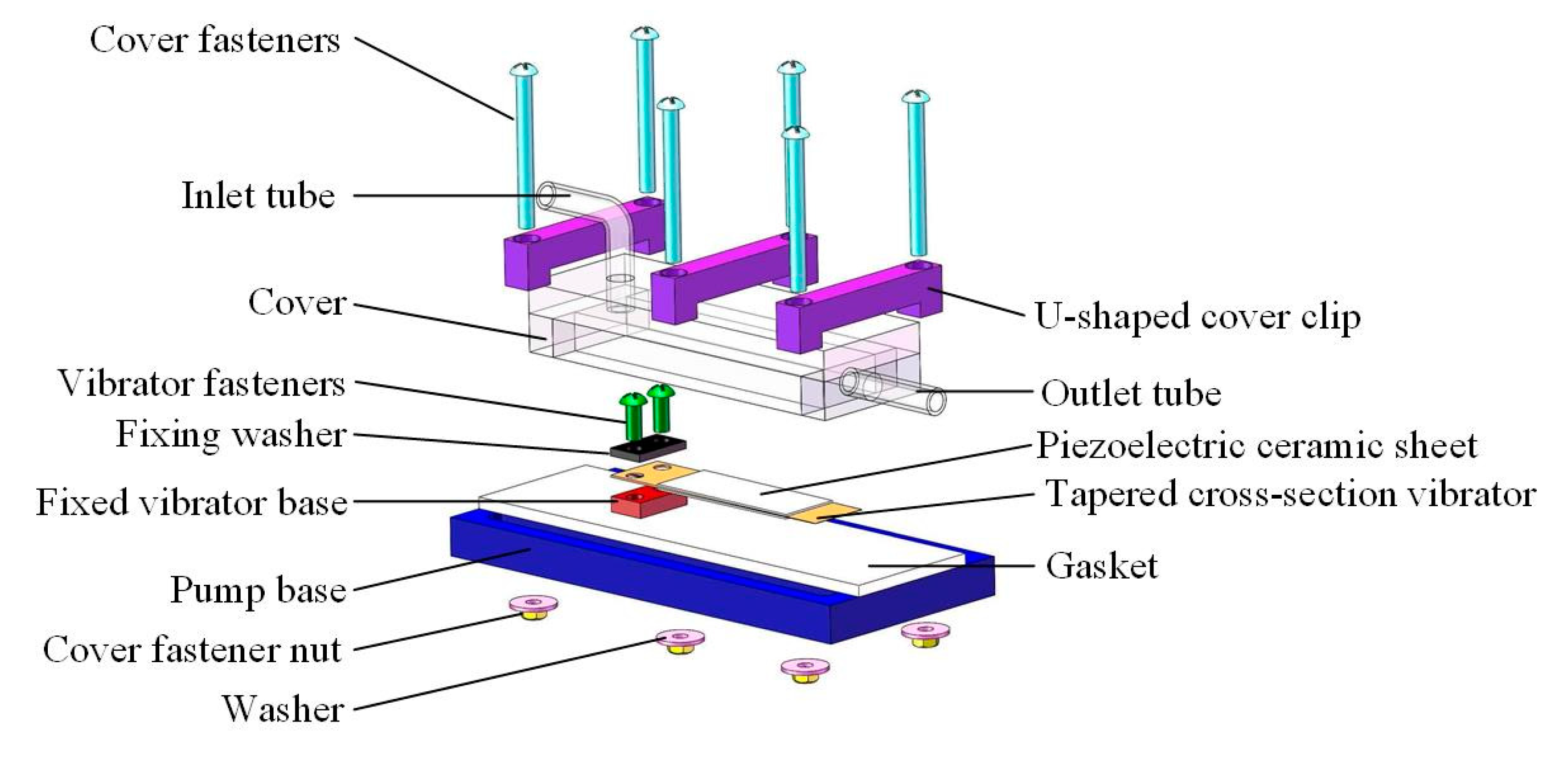
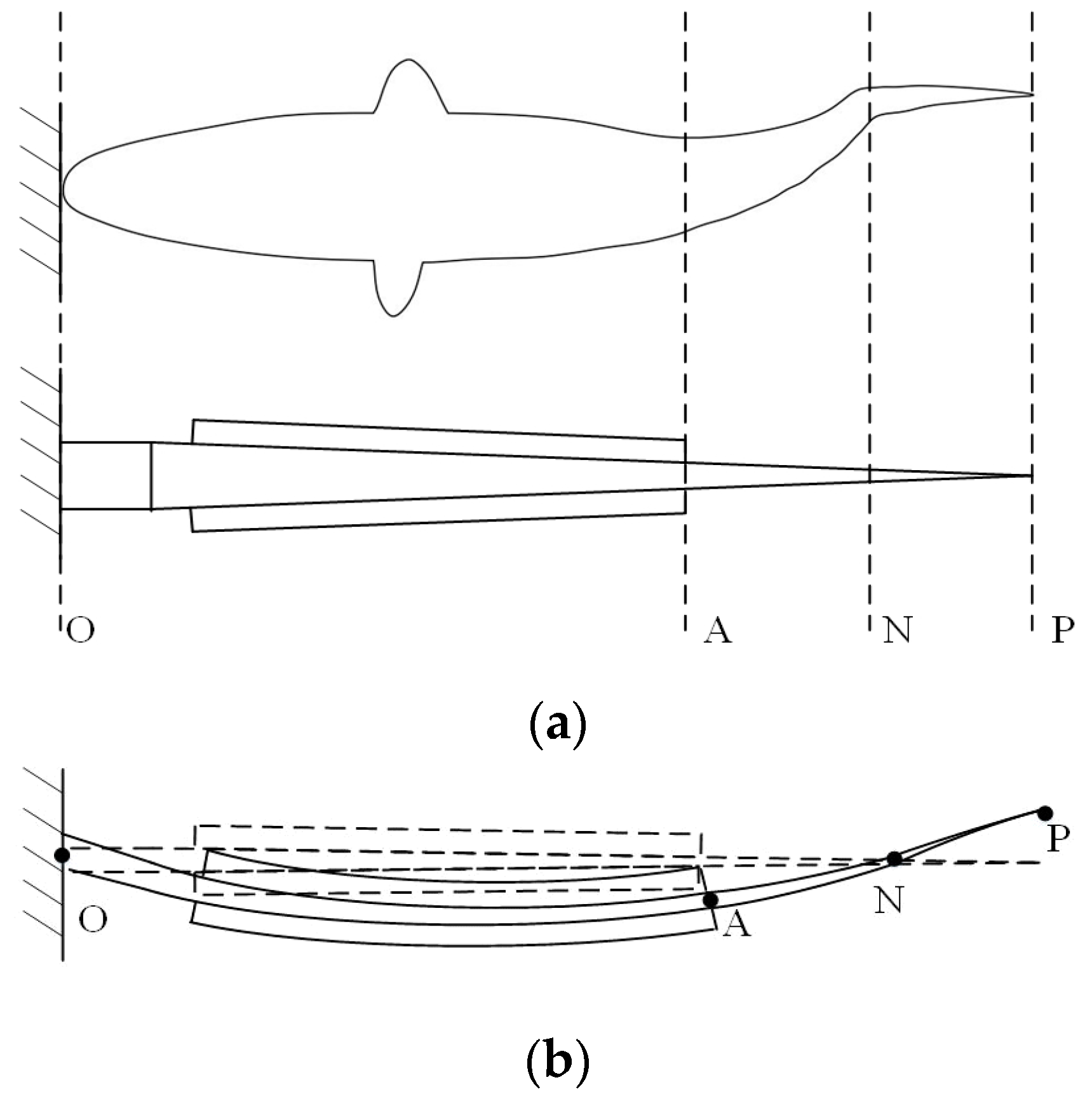
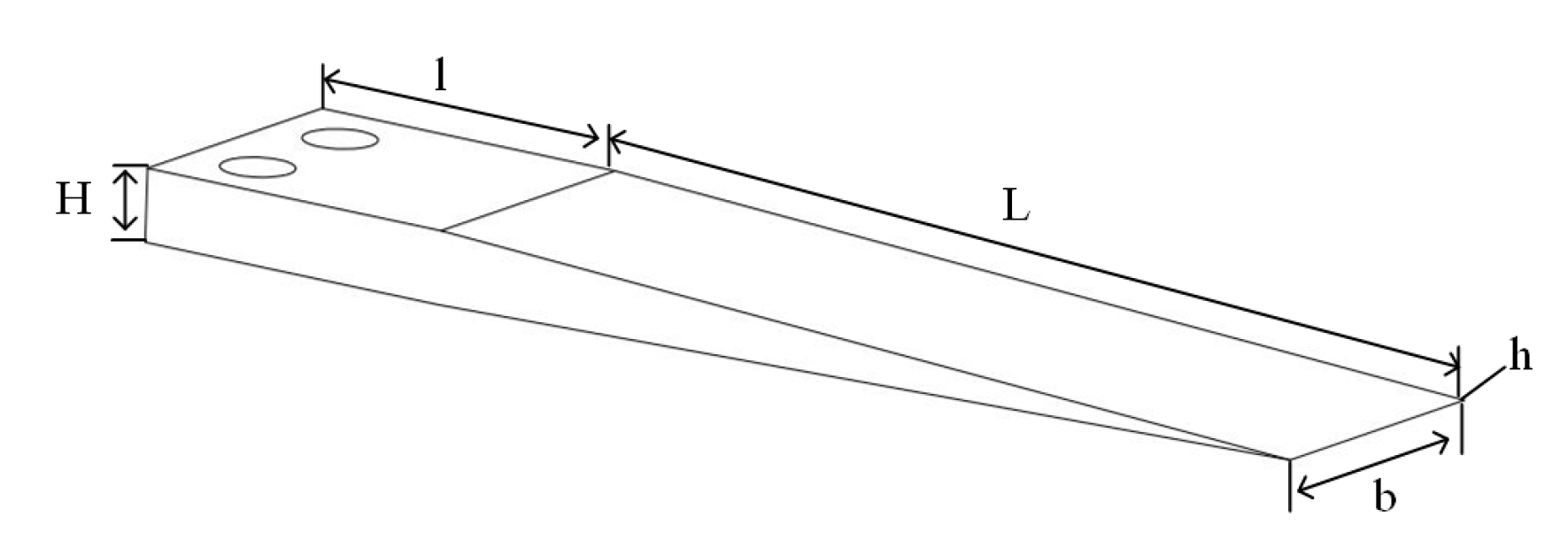

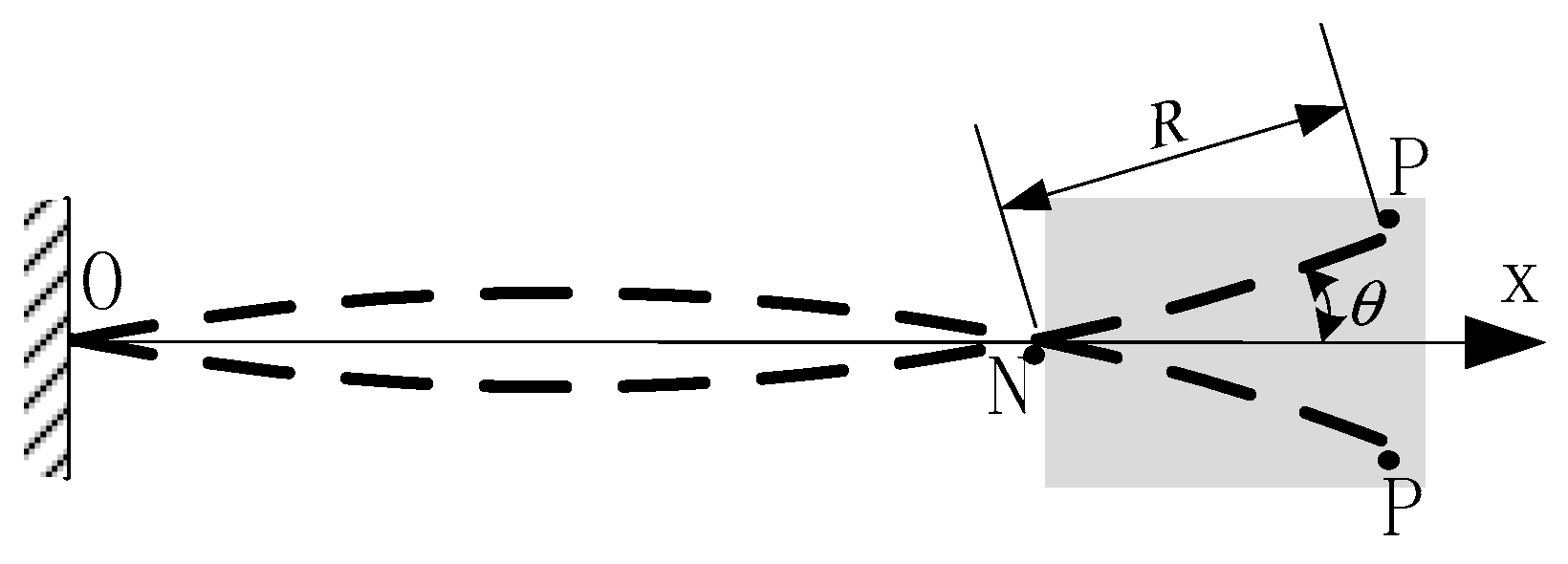
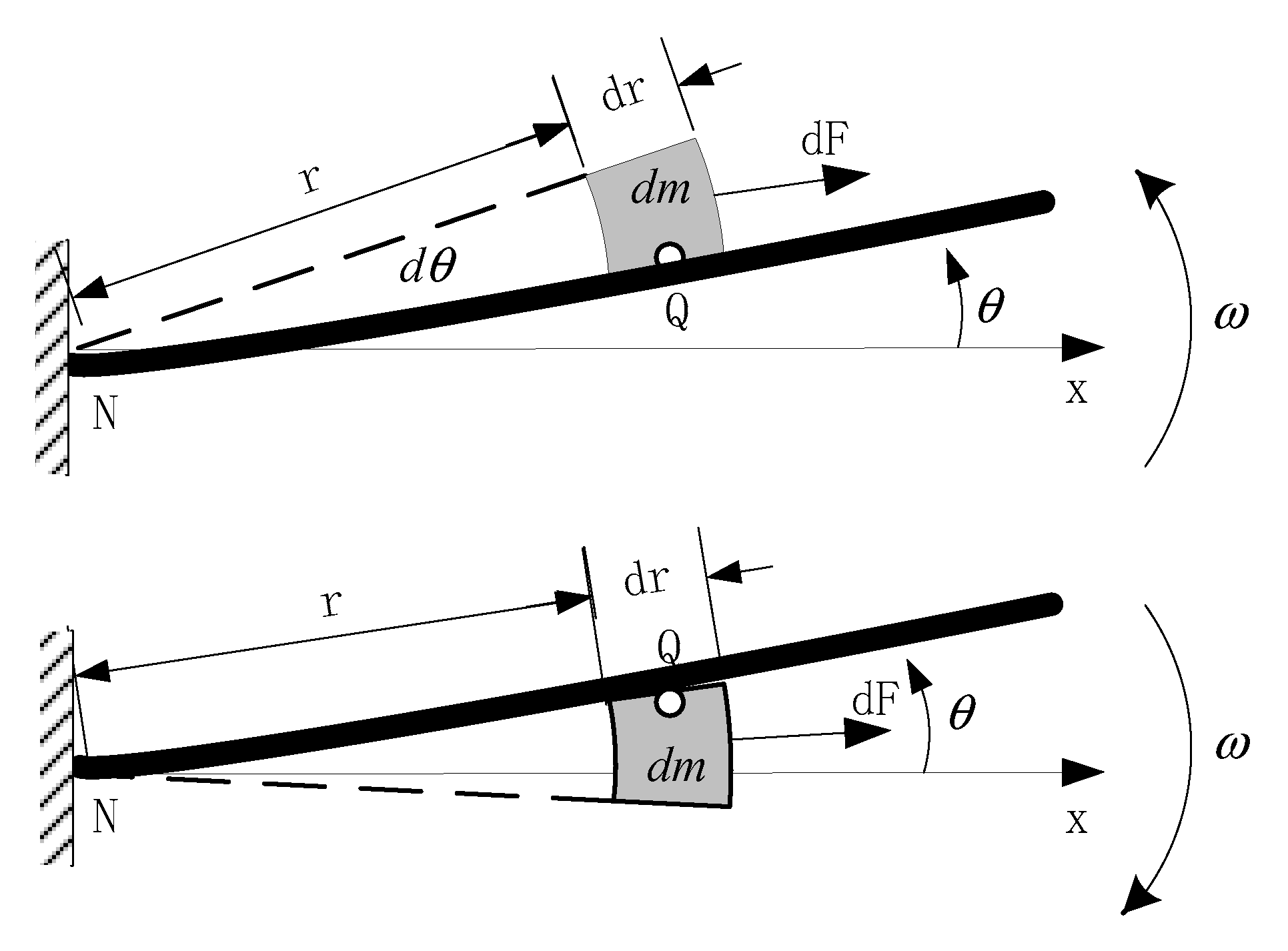

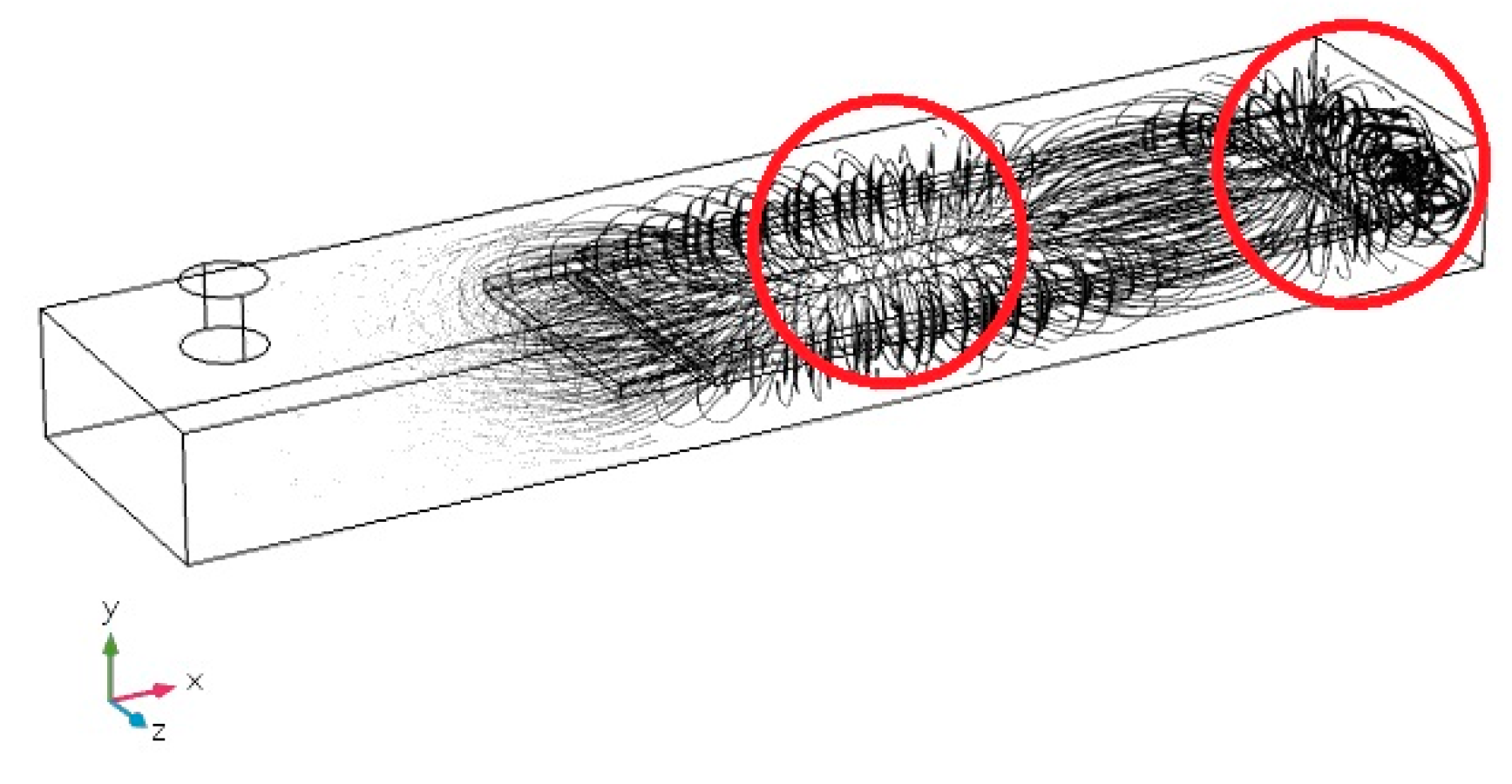
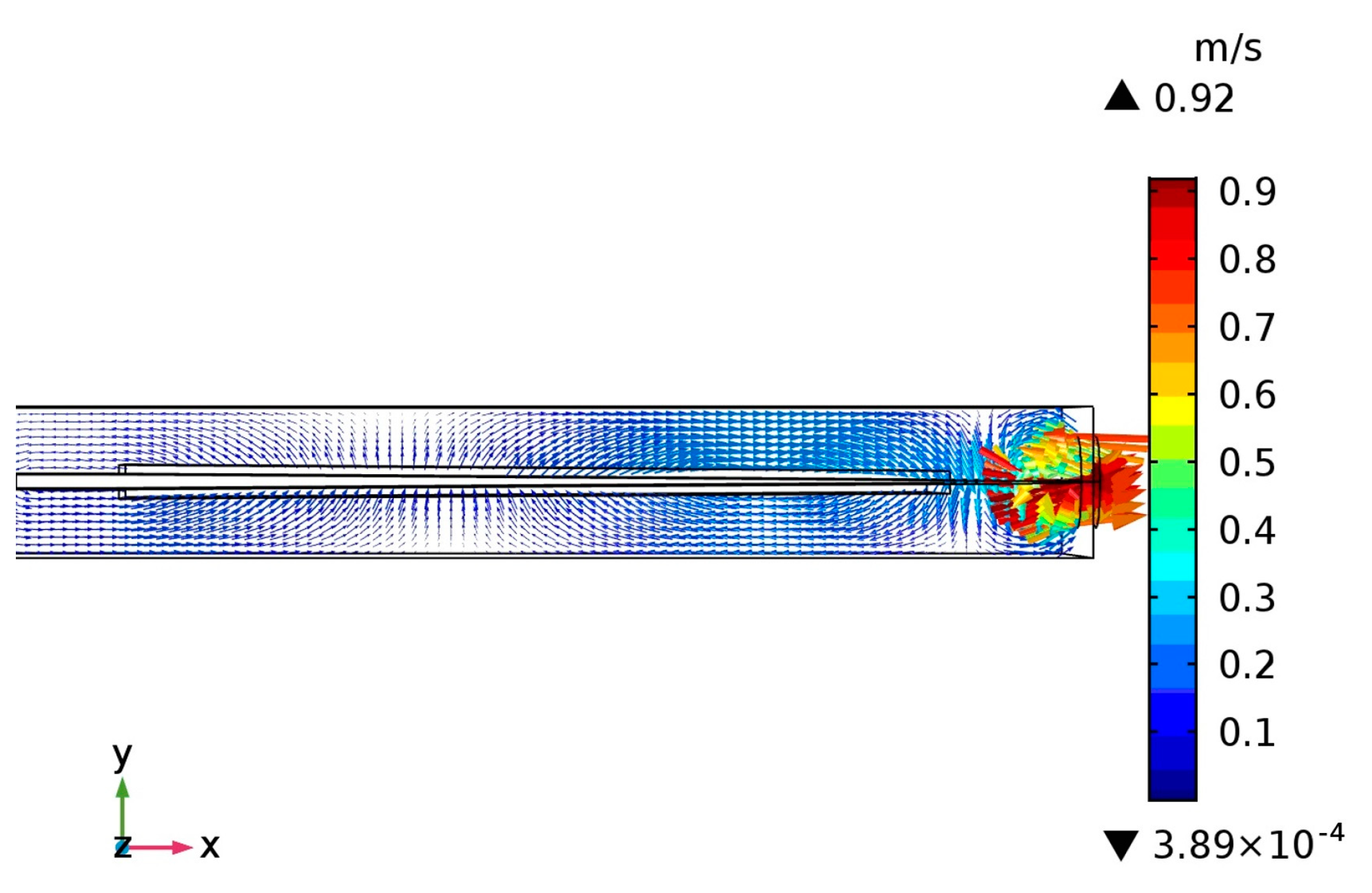

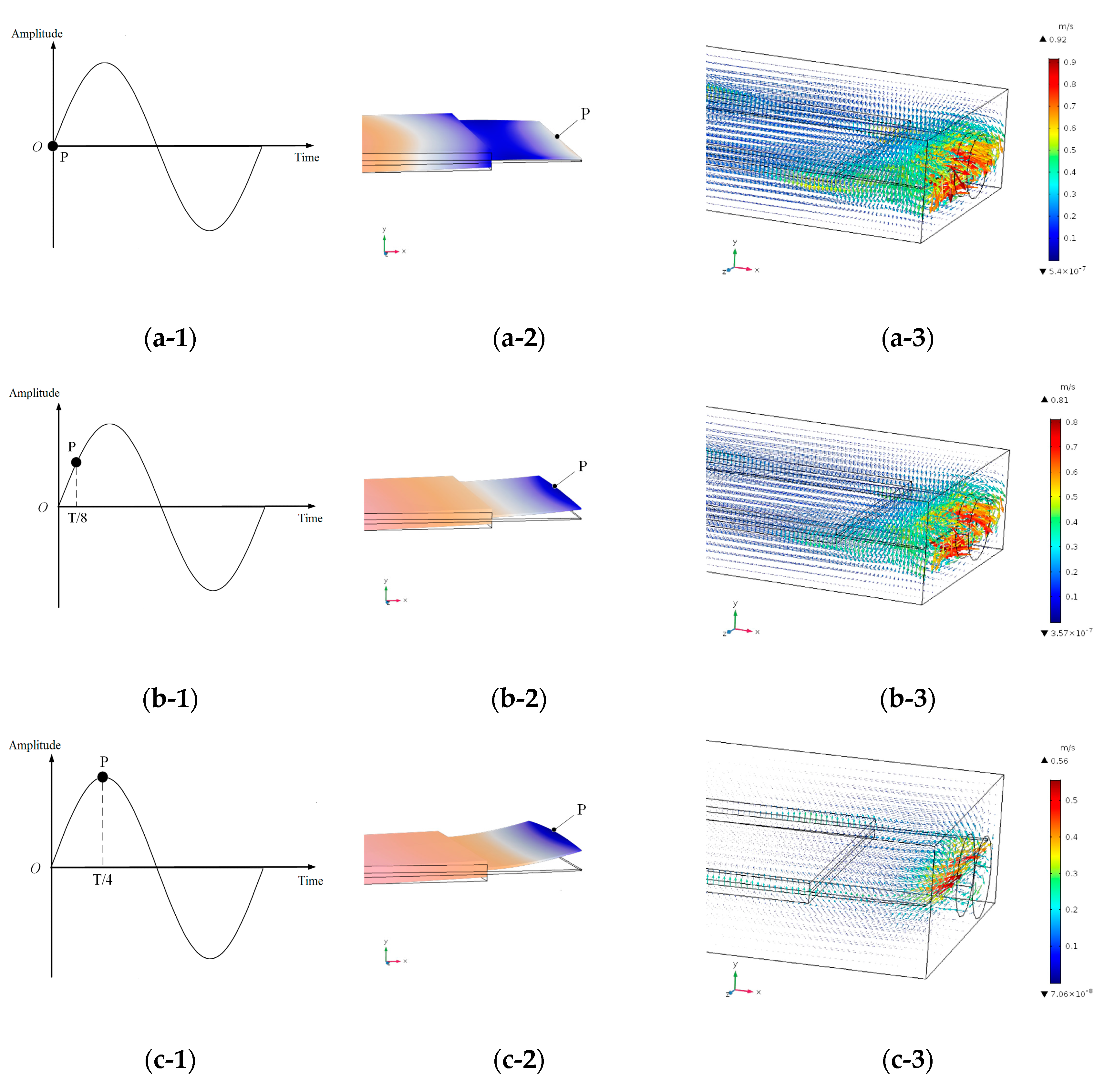
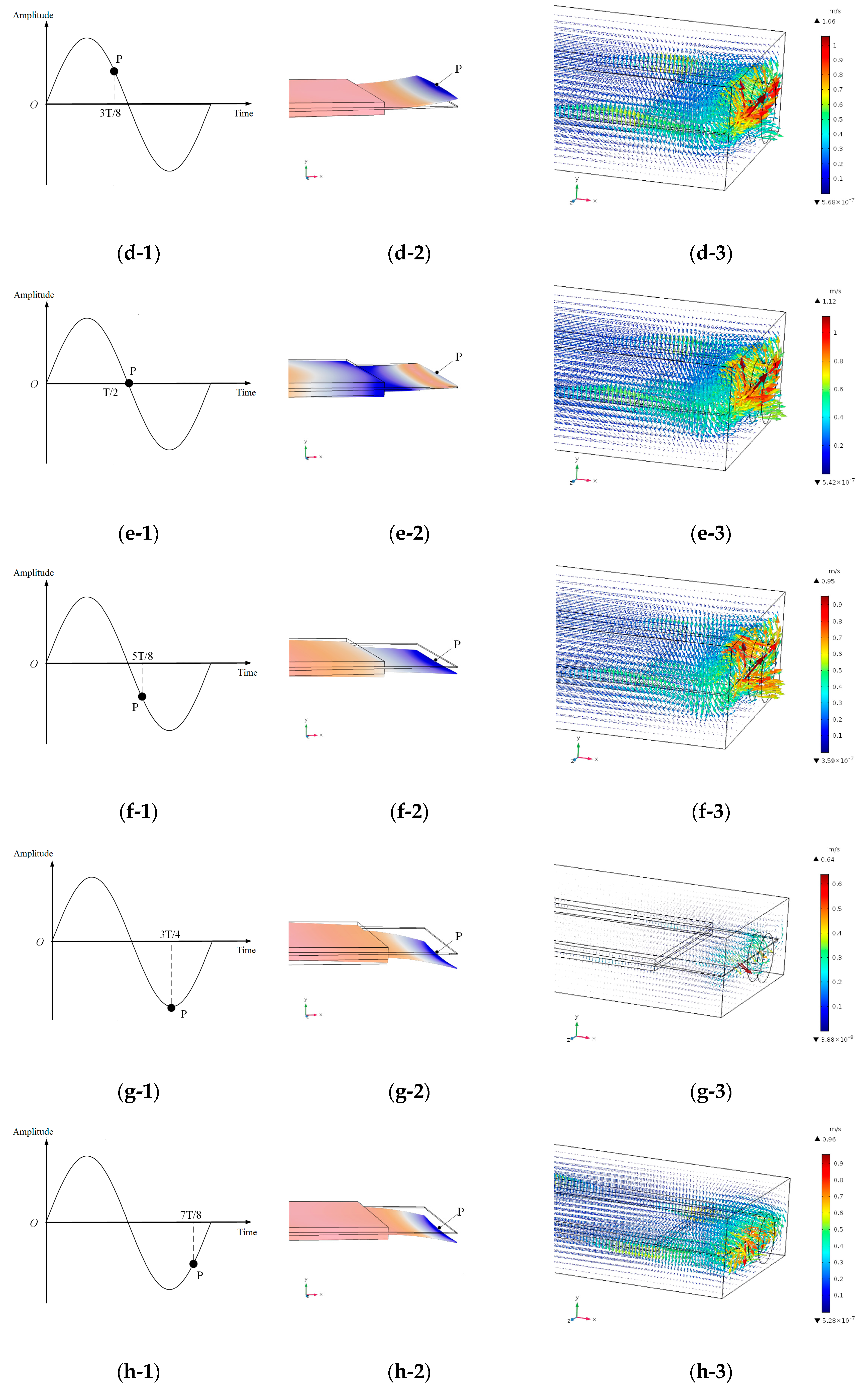


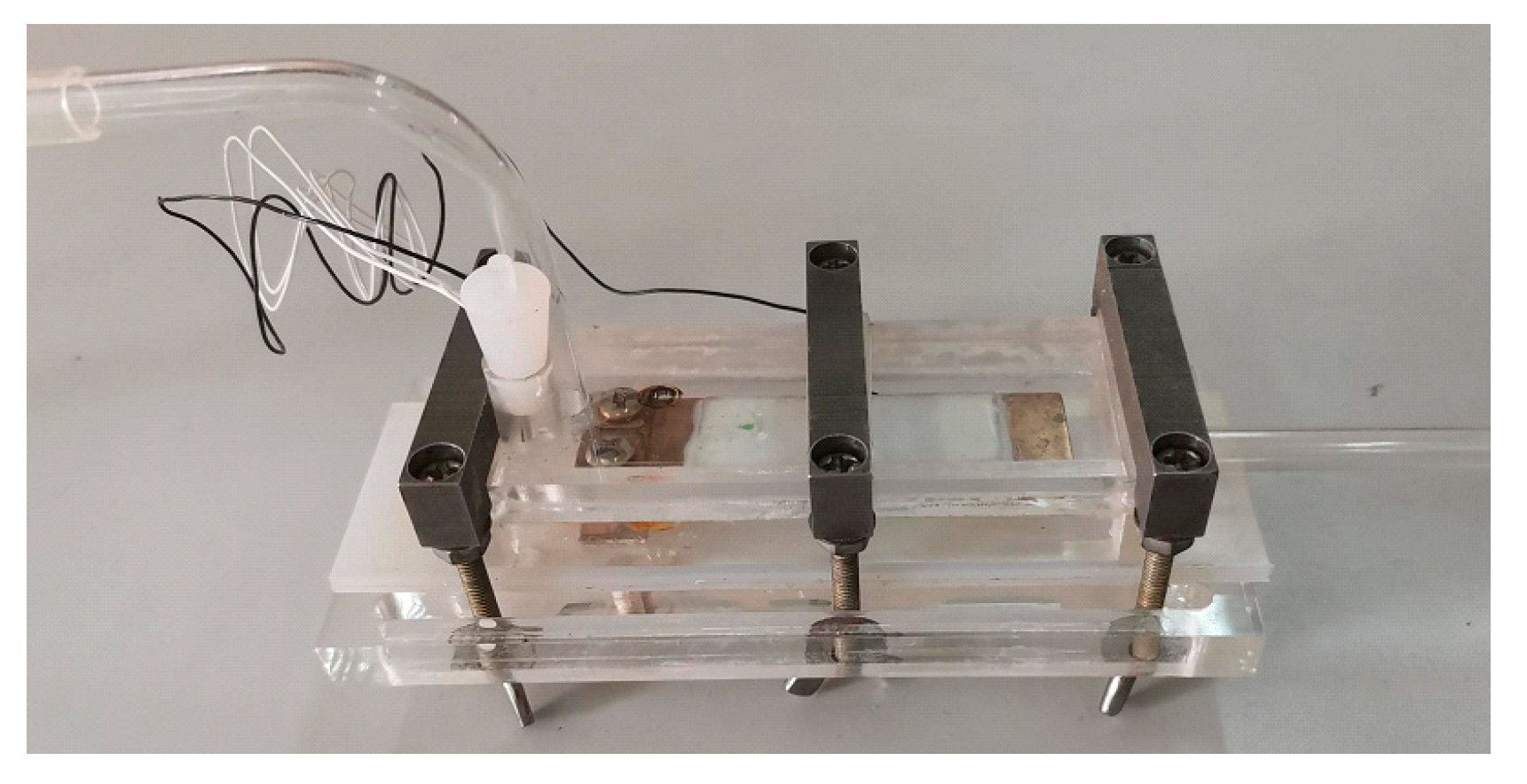
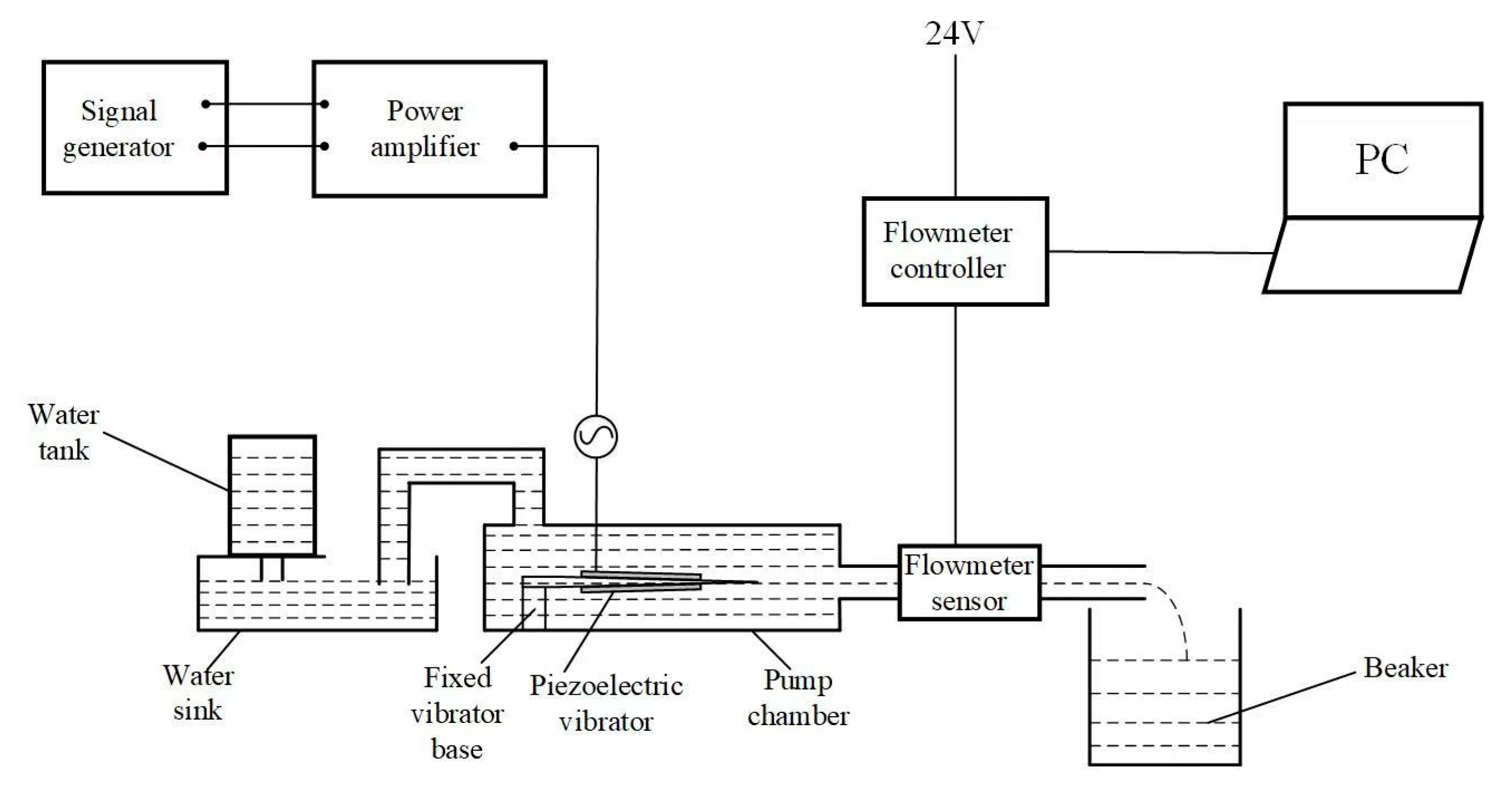

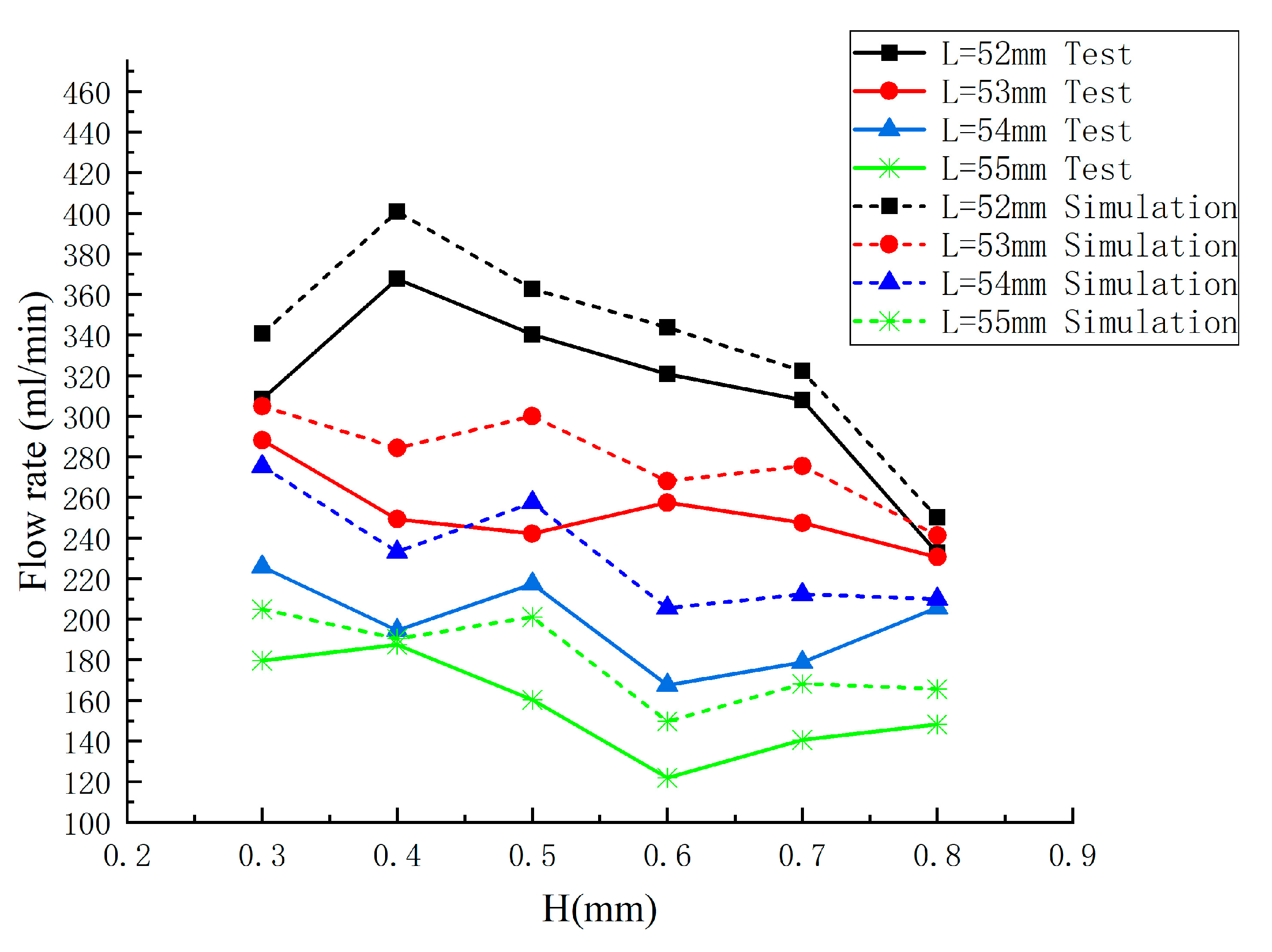
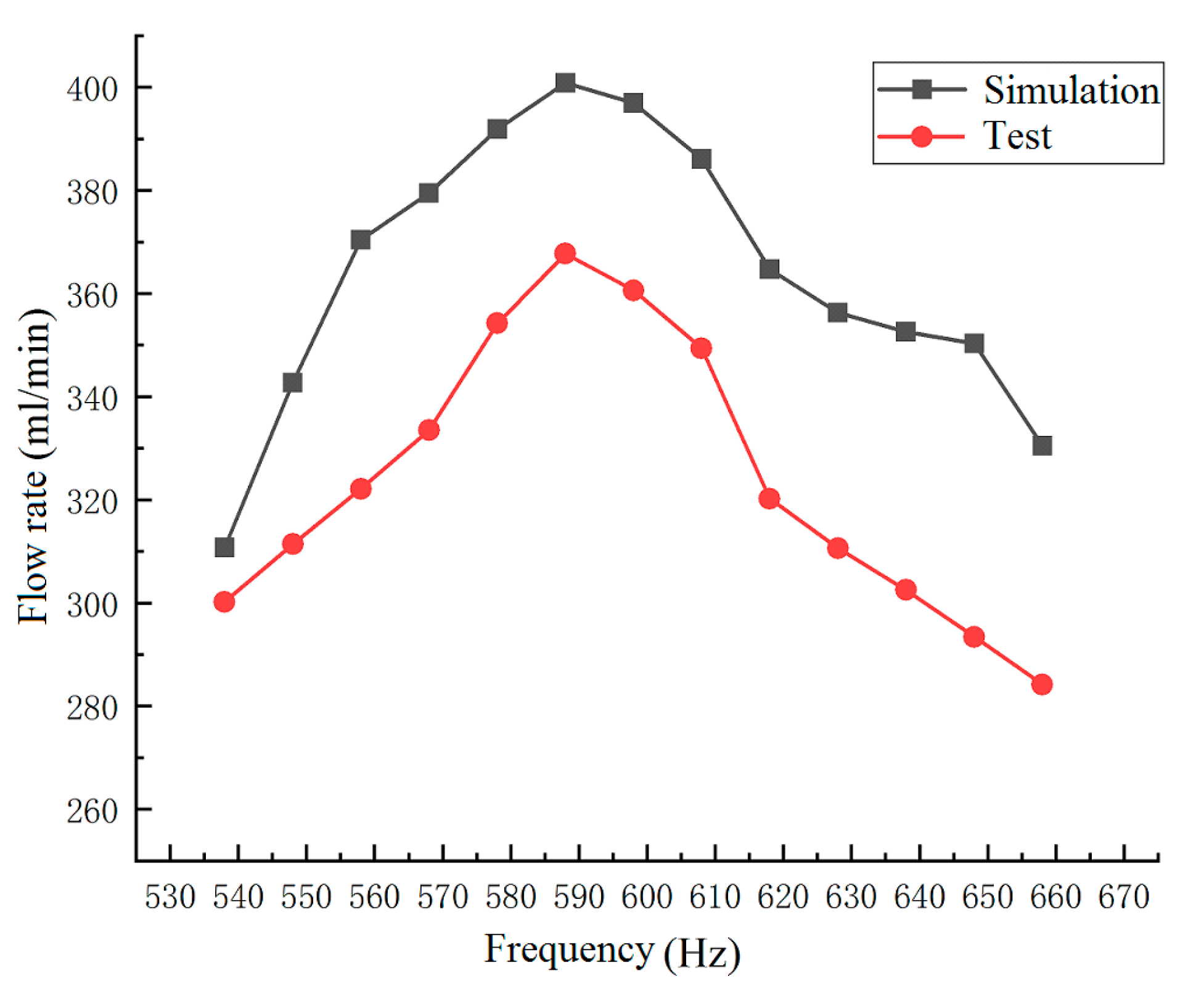
| Parameter | Value (mm) |
|---|---|
| H | 0.3–0.8 |
| h | 0.1 |
| l | 15 |
| L | 52–55 |
| b | 16 |
| Length of the piezoelectric ceramic sheet | 44 |
| Width of the piezoelectric ceramic sheet | 16 |
| Thickness of the piezoelectric ceramic sheet | 0.5 |
| Parameter | Value |
|---|---|
| Relative dielectric constant | |
| Piezoelectric coefficient | (C/N) |
| Capacitance C | (F) |
| Simulation Number | Mesh Element Quantity | Simulation Flow Rate Q (mL/min) |
|---|---|---|
| 1 | 8356 | 653 |
| 2 | 15,783 | 557 |
| 3 | 26,642 | 419 |
| 4 | 33,865 | 400 |
| 5 | 47,231 | 402 |
| 6 | 64,724 | 398 |
| 7 | 144,625 | 401 |
Disclaimer/Publisher’s Note: The statements, opinions and data contained in all publications are solely those of the individual author(s) and contributor(s) and not of MDPI and/or the editor(s). MDPI and/or the editor(s) disclaim responsibility for any injury to people or property resulting from any ideas, methods, instructions or products referred to in the content. |
© 2024 by the authors. Licensee MDPI, Basel, Switzerland. This article is an open access article distributed under the terms and conditions of the Creative Commons Attribution (CC BY) license (https://creativecommons.org/licenses/by/4.0/).
Share and Cite
Hu, C.; Jiang, W.; Hu, X.; Ji, J.; Li, S.; Zhang, Q. Simulation Analysis and Experiment of Piezoelectric Pump with Tapered Cross-Section Vibrator. Appl. Sci. 2024, 14, 7418. https://doi.org/10.3390/app14167418
Hu C, Jiang W, Hu X, Ji J, Li S, Zhang Q. Simulation Analysis and Experiment of Piezoelectric Pump with Tapered Cross-Section Vibrator. Applied Sciences. 2024; 14(16):7418. https://doi.org/10.3390/app14167418
Chicago/Turabian StyleHu, Caiqi, Wei Jiang, Xiaoqi Hu, Jing Ji, Shengduo Li, and Qingbo Zhang. 2024. "Simulation Analysis and Experiment of Piezoelectric Pump with Tapered Cross-Section Vibrator" Applied Sciences 14, no. 16: 7418. https://doi.org/10.3390/app14167418




